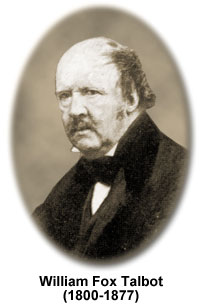William Fox Talbot
(1800-1877)

William Fox Talbot, an English chemist, philosopher, mathematician, linguist, and Egyptologist, is best known for the innovative photographic techniques he developed. His work in the mid-1800s is the foundation upon which modern photography is based.
Born on February 11, 1800 in Dorset, England, Talbot came from an upper class family with a renowned lineage. His father was an influential military man, but died when Talbot was only five months old. His mother, Lady Elisabeth, remarried in 1804 and Talbot gained Charles Feilding as a stepfather. Talbot demonstrated an inquisitive nature at a young age and was educated at Harrow and Trinity College in Cambridge. After graduation he spent time traveling and occupied himself with research in a variety of fields. He married in 1832, followed by a brief political career, serving in Parliament from 1833 to 1834.
Talbot's interest in photography arose while he was visiting Italy with his wife in 1833. The fact that he could not capture the beauty of nature as he traveled was his inspiration, and he is quoted:
"It was during these thoughts [of the beauty of pictures] that the idea occurred to me - how charming it would be if it were possible to cause these natural images to imprint themselves durably and remain fixed upon the paper."
When he returned from vacation, he began experimenting with photography and, by the fall of that same year, he produced his first photographs, or photogenic drawings as he called them, by placing objects, such as leaves or lace, on top of silver salt-sensitized paper and exposing it to sunlight. The result was what is now called a negative image, in which bright areas of an image appear dark, and dark areas appear light. The advantage that Talbot realized in first printing a negative image was that any number of duplicate images could be made from the original negative. Soaking the paper negative in oil made it transparent, and it could then be contact printed onto other pieces of sensitized paper to create positive images.
Talbot described his photographic system in a letter in 1835, but did not publicize his work, believing that he should further perfect it before it was revealed to the world. He was also simultaneously working on other projects in the 1830s, including a book entitled Hermes, or Classical and Antiquarian Research. He postponed his photographic efforts until he became aware of the work of Louis-Jacques-Mandé Daguerre in January, 1839. Hurriedly, Talbot attempted to secure recognition for his own photographic process, which was presented to the Royal Institution later that same month. He even contacted Francois Arago, who had ardently promoted Daguerre's invention, to claim that he was the true inventor of photography. However, examination of the scientist's work proved that Daguerre's process was completely different from that of Talbot, and developed independently.
While Daguerre's photographic process was gaining in popularity, Talbot renewed his experiments in photography and improved his technique. In 1840, he made an important advance when he developed the first latent negative photographic image with the aid of a gallic acid wash. Talbot named his altered process the Calotype, derived from the Greek word for beautiful, and secured patents for it in England, Wales, and France. The technique that would later become known as Talbotype had several advantages over other photographic methods of the time, but would never gain the same widespread use as the daguerreotype, which was only restricted by patent in England, and created clearer images, though they could not be duplicated. Photographer's wishing to use Talbot's process had to buy the rights, a great deterrent to those who could use the daguerreotype freely. Moreover, Talbot stringently pursued infringements, which ultimately hurt his reputation when a claim, in 1854, that the wet collodion process fell under his patent was lost in court.
Talbot continued his work despite any disappointment he might have felt, and other notable achievements include the publication of the first book containing photographs and the development of photoetching, which was patented as photoglyphy in 1858. He is also known for his use of fine mesh screens in conjunction with photography, a technique that became the basis of the halftone plates developed in the 1880s. Talbot was not only innovative, but had great technological foresight. He predicted the invention of both infrared photography and microfilm, although he would not live to see them developed, dying on September 17, 1877 in his home, Lacock Abbey.
